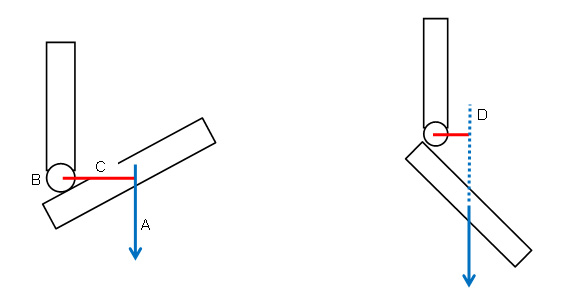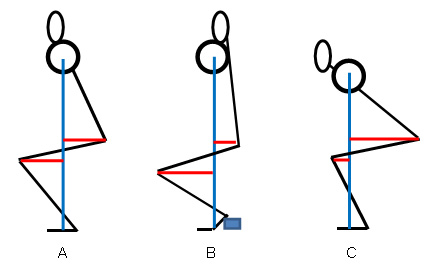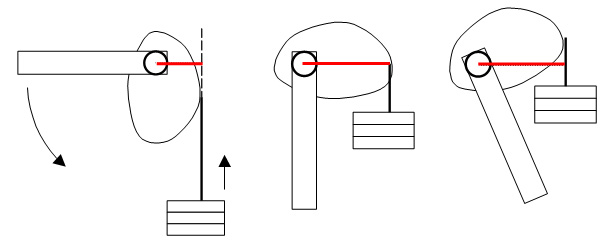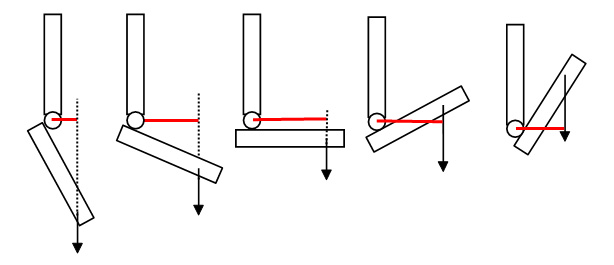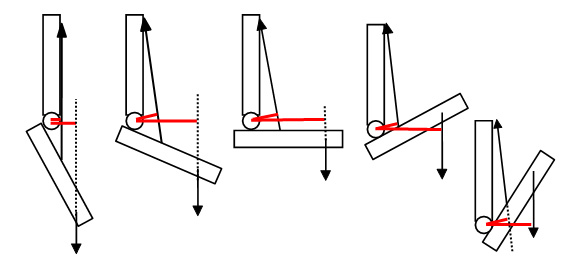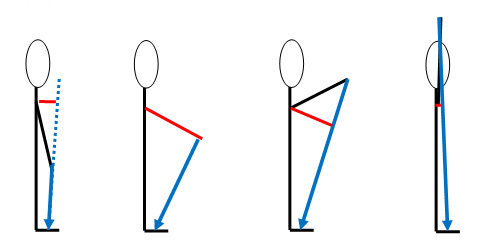Moment Arm
Definition
A moment arm (MA) determines the degree of effectiveness or influence of a force to produce or prevent the rotation of an object around an axis.
The moment arm is the shortest distance from the line of force to the axis. Geometrically it is the perpendicular distance from the line of force to the axis,
i.e. it is always perpendicular to the line of force.
To identify the length of the moment arm at any specific position during the movement of an object around an axis:
- Identify the specific line of force in question (A)
- Note: There are often multiple forces acting around a given axis
- Identify the specific joint axis in question (B)
- Note: There are often multiple axes affected by a line of force
- Identify the line that is perpendicular to the line of force AND intersects the axis (C)
- Note: If the line of force (cable, gravity, muscle, etc.) does not appear to offer a perpendicular relationship to the axis at any point along it’s depicted or envisioned length, the line must be extended (mentally or graphically) in order to identify the moment arm (D)
Moment Arm and Torque
Torque is often described as “a twisting force” or “a force that causes rotation”, but these descriptions are incomplete because a force can only cause rotation if it is applied at some distance from the axis, i.e. the line of force must not intersect the axis; there must be a moment arm. “A force applied at some distance from an axis, causing or prevents a twist or rotation” would be more accurate.
Torque is the product of the force applied around an axis times its distance from the axis or moment arm. (T = F x MA). Therefore, torque is directly proportional to both the magnitude or amount of force and its moment.
Moment Arm, Torque, and “Moment”
“Moment” is commonly considered synonymous with moment arm. However, colloquially, moment is also used as a synonym for torque. In essence the word moment represents the rotational influence of any specified force, e.g. moment of inertia is another term for rotational inertia which is represents how inertia is influenced by the mass’s distance from the axis ( Ir = mr2 )
Importance in Exercise
Every human movement is created by one or more joints rotating around their respective axes. Gross linear movements such as a squat (linear in that the center of mass must move vertically in a virtual straight line maintained over the base of support) are produced via multiple joints rotating in the required angular proportions. With this understanding it becomes necessary to recognize that virtually every force applied to or created within the human body is creating torque, and therein its influence upon either moving or stabilizing is determined as much by the moment arm of the force as the amount of force. Moment arm is one of the many reasons why the number on the weight does not accurately represent the true resistance and one of the reasons why what’s moving and what’s challenged can be unrelated.
Resistance Distribution
Regardless of the amount of load, the actual degree of challenge at each joint is determined by the moment to that joint.
A squat is often called a total body exercise, but it does not challenge each part of the body equally (nor should it, as each joint and its associated musculature have drastically varying mechanical abilities).
Although extremely oversimplified, these examples represent the distribution of the resistance between the hip and the knee. Although there are many factors involved (some that may be manipulated and some that may not) three very different experiences and outcomes can be expected from the squats as shown.
In squat A the load is distributed equally between the hip and knee because the moments are equal. However, one is likely to experience greater knee extensor challenge than hip extensor challenge because the torque producing capabilities at the two joints are not equal, i.e. typically hip extensor strength is greater than knee extensor strength.
In squat B load position has influenced body position in such a manner that a larger moment of resistance is created at the knee, which is often why it is stated in lay terms that “front squats emphasize quads”.
In squat C a larger moment is created at the hips (and lumbar spine). It is likely that this individual will experience squats as primarily a “butt and low back exercise” because that is exactly what is being challenged due to the moments of resistance. Fatigue/failure in the low back is likely to preclude any noticeable challenge to the quadriceps.
Note: These examples of resistance distribution via comparative moment lengths are not intended as a complete analysis of squats, squat variations, related joint forces, exact muscular recruitment, etc. nor does this section or website offer recommendation or opinion regarding any version of squatting for any specific individual, goal, stage of progression, etc.
Strength Profiles
Strength is influenced by many factors, but at any given joint the fundamental mechanical elements of strength are the factors that influence internal torque production throughout a given range of motion: the Length-Tension Relationship of the involved musculature (the combined influences of active tension and passive tension as they vary throughout the shortening-lengthening cycle, as well as fatigue) and the associated moments of each muscle group (or the resultant thereof) as they change at every point in the range.
Ultimately, strength varies from start to finish in all human movements due in large part to the normal variations in the moments of the internal force producers that occur predictably and measurably throughout any considerable range of motion.
Resistance Profiles
Because resistance to human movement is always torque, we cannot measure it solely by the amount of force (i.e. one’s bodyweight, the number on the end of the dumbbell, or attached to the cable). The changing moment of resistance to every involved joint (be it moving or static) creates a predictable and measurable variation in challenge throughout the range of motion.
If the source of resistance utilized is one that changes in magnitude throughout the range (tubing, mass/inertia, etc.) then this further influences the torque of resistance.
Strategic manipulation of the moment of resistance (in concert with a strategic choice of the source of resistance based upon its properties) is vital to creating optimal and appropriate Resistance Profiles for specific individuals and goals. This is the key to creating “full range challenge” without which “full range of motion” of minimal value.
Examples
Cams
As it rotates a cam manipulates either the moment arm of resistance (below) or effort. If designed appropriately it will generate a strategically appropriate alteration in (or maintenance of) torque throughout each point of the range of motion.
Note: The final output of the machine is the sum of the combined changes occurring within the machine throughout the chosen range, which may include multiple cams and/or lever systems. It is vital to recognize that the machine’s final output does not constitute the resistance profile of the exercise, only the magnitude profile of the resistance. The actual resistance profile can only be determined by comparing these magnitude changes to the concurrent changes in moment to the user’s joints throughout the range. This is where the force from the device actually becomes torque to the body and therein, the resistance for the exercise.
Internal Torque Production
The patella is one of the best examples of both moment arm and structural influence in one’s “strength”. Often referred to as an anatomical pulley, the patella really acts more like an anatomical cam, dramatically altering the moment of the quadriceps collective line of force. Surgical removal of the patella (for decades the common treatment for fracture) rendered the knee extensors virtually powerless to straighten the knee under load regardless of the tension producing capabilities of the quadriceps.
Characteristics of Moments
1. If a direction of force remains consistent while a limb rotates at a joint, the moment arm will change with every degree of motion. This simply means that the force will have different degrees of influence at every position comprising the range of motion.
2. There will be a different moment for each force that acts upon a joint axis: internal force or external force, effort force or resistance force.
3. A single force can influence every involved joint. There will be a separate moment to each joint, the length of which will determine the degree of challenge to the musculature surrounding that joint.
4. A moment arm can never be longer than its associated lever arm. I.e. the length of the lever will be the maximal length of the moment. It can be shorter than the lever but never longer.
5. The maximal moment for a given scenario will occur when the force angle is “optimal” (90˚). Any degree less than or greater than 90 will produce a smaller moment.
A 45˚ force angle and a 135˚ force angle will produce the same moment because they are the same distance from 90˚.
6. When the force angle is 90˚ the lever arm and the moment arm coincide, i.e. are the same length and occupy the same space.
Misconceptions
Moment arm is the most vital mechanical factor that is consistently ignored by the exercise industry, experts and consumers alike. When presented in formal study it is with such poor examples and lack of reverence that one must assume that the professors themselves don’t really understand its importance in exercise. Below are just a few of the numerous examples of moment arm neglect or misunderstanding.
Moment Arms and Lever Arms Are Not the Same!
Many teachers, certifying organizations, and textbooks now state that “moment arms and lever arms are the same.” The problem appears to lie in their limited exploration beyond the traditional example offered: the balanced first class lever system (seesaw). In a balanced seesaw the moment arm (perpendicular distance from the line of force to the axis) happens to coincide with the lever arm (the distance from the point of application of the force to the axis) because the force angle is 90˚. If the seesaw is shown unbalanced it becomes obvious that these two are very different.
Free Weights Are Not Constant Resistance
Page 207 of ACSM’s Resource Manual for Guidelines for Exercise Testing and Prescription, 5th edition lists “Key Terms” under which it states “Free weight exercise (constant resistance): To use constant load based on barbells or dumbbells throughout range of motion.” The only free weight that is constant resistance is one that is not moving. A weight that is moving will be a variable resistance due to the potentially dramatic influence of inertial effects, and a weight moving around an axis will always be a variable resistance due to the constantly changing moment arms to each involved joint.
Cables Are Not Constant Resistance
A Poliquin™ Training Article entitled “Machines vs. Free Weights?” Lists “Isolation exercise with constant resistance machine (e.g. Scott pulley curls, triceps pressdown on pulley machine)”. We have to assume that the article is referring to a cable applying the resistance as it is unlikely that a “pulley” is attached to the body. Any exercise utilizing a cable directly applied to the body will be a variable resistance throughout the range of motion due to the constantly changing moment to the involved joint/s. It also lists “Complex exercise with constant resistance machine (e.g. leg press on a standard machine)”. If this is referring to a 45˚ leg sled (or any other leg press for that matter) then the resistance is again variable as the moment to each joint will change with every degree of motion and therein will alter the torque of resistance throughout the range.
It might also be noted that “cam-type machines” are listed as “variable resistance”. While this is typically true, it must be noted ironically that a machine, if it were designed with a perfectly round cam whose magnitude was applied radially to a limb, could be the only source of truly “constant resistance”.
Tubing: Greater Stretch Is Not Always Greater Resistance
NSCA states in The Essentials of Strength Training and Conditioning, page 47, that “The most obvious characteristic of elastic resistance is that the more the elastic component is stretched, the greater the resistance…” It is true that the greater the stretch the greater the tension or magnitude of resistance, but this is only half the equation because we must remember that resistance to the body is torque, not just force alone. The moment is an equally influential factor and if the moment to a particular joint gets close enough to zero, the resistance at that joint will be insignificant. In the examples below the greatest length of tubing will produce virtually no resistance at the shoulder.
Tubing Chest Press
The NSCA’s Essentials of Personal Training, page 317, shows a “Chest Press (Resistance Band)”: a standing, forward pressing, upper extremity exercise with tubing wrapped around the torso just below the arm pit. The top view of this exercise depicted below illustrates that the tubing wrapped around the torso produces a zero moment at the shoulder joint throughout the entire range, and therefore no resistance in that plane at the shoulder joint which would require the chest (pectoralis major) to be recruited any more than would horizontally adducting the shoulder in a standing position without the tubing (a position in which the movement is unresisted by gravity). There is a significant moment resisting elbow extension, at least at the start.
Related Topics
- Force
- Resultant
- Lever Arm
- Force Angle
- Force Angle Components
- Lever Systems
- Joint Axis

